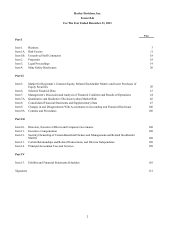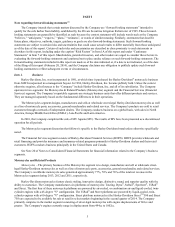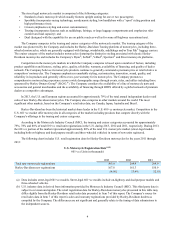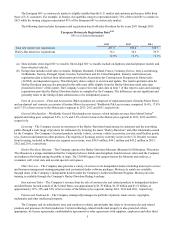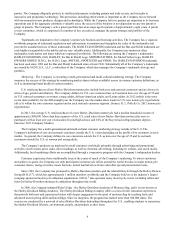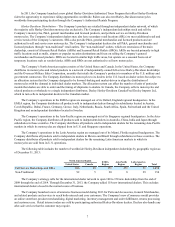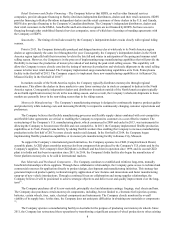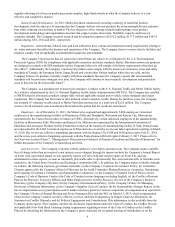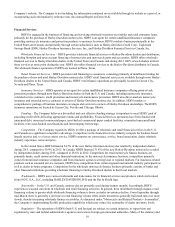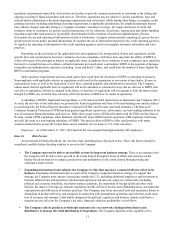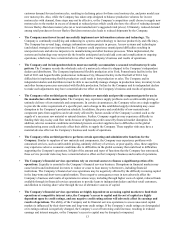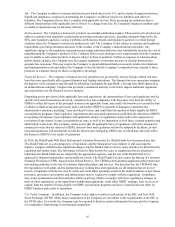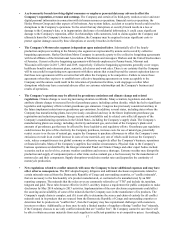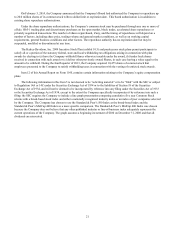Harley Davidson 2013 Annual Report Download - page 12
Download and view the complete annual report
Please find page 12 of the 2013 Harley Davidson annual report below. You can navigate through the pages in the report by either clicking on the pages listed below, or by using the keyword search tool below to find specific information within the annual report.12
independent dealers and distributors to develop and implement effective retail sales plans to create demand among
retail purchasers for the motorcycles and related products and services that the dealers and distributors purchase from
the Company. If the Company’s independent dealers and distributors are not successful in these endeavors, then the
Company will be unable to maintain or grow its revenues and meet its financial expectations. Further, independent
dealers and distributors may experience difficulty in funding their day-to-day cash flow needs and paying their
obligations resulting from adverse business conditions such as weakened retail sales and tightened credit. If dealers are
unsuccessful, they may exit or be forced to exit the business or, in some cases, the Company may seek to terminate
relationships with certain dealerships. As a result, the Company could face additional adverse consequences related to
the termination of dealer relationships. Additionally, liquidating a former dealer’s inventory of new and used
motorcycles can add downward pressure on new and used motorcycle prices. Further, the unplanned loss of any of the
Company’s independent dealers may lead to inadequate market coverage for retail sales of new motorcycles and for
servicing previously sold motorcycles, create negative impressions of the Company with its retail customers, and
adversely impact the Company’s ability to collect wholesale receivables that are associated with that dealer.
• Changes in general economic conditions, tightening of credit, political events or other factors may adversely
impact dealers’ retail sales. The motorcycle industry is impacted by general economic conditions over which
motorcycle manufacturers have little control. These factors can weaken the retail environment and lead to weaker
demand for discretionary purchases such as motorcycles. Tightening of credit can limit the availability of funds from
financial institutions and other lenders and sources of capital which could adversely affect the ability of retail
consumers to obtain loans for the purchase of motorcycles from lenders, including HDFS. Should general economic
conditions or motorcycle industry demand decline, the Company’s results of operations and financial condition may be
substantially adversely affected. For instance, the European region has faced an ongoing recession, which resulted in
lower consumer confidence, high unemployment and constrained credit that negatively impacted retail motorcycle
sales. The motorcycle industry can also be affected by political conditions and other factors over which motorcycle
manufacturers have little control.
• Retail sales of the Company's independent dealers may be impacted by weather. The Company has observed that
abnormally cold and/or wet conditions in a region could have the effect of reducing demand for new Harley-Davidson
motorcycles. Reduced demand for new Harley-Davidson motorcycles ultimately leads to reduced shipments by the
Company.
• The Company may not be able to successfully execute its manufacturing strategy. The Company’s manufacturing
strategy is designed to continuously improve product quality and increase productivity, while reducing costs and
increasing flexibility to respond to ongoing changes in the marketplace. The Company believes flexible
manufacturing, including flexible supply chains and flexible labor agreements, is the key element to enable
improvements in the Company’s ability to respond to customers in a cost effective manner. To implement this strategy,
the Company must be successful in its continuous improvement efforts which are dependent on the involvement of
management, production employees and suppliers. Any inability to achieve these objectives could adversely impact
the profitability of the Company’s products and its ability to deliver the right product at the right time to the customer.
• The Company’s ability to remain competitive is dependent upon its capability to develop and successfully
introduce new, innovative and compliant products. The motorcycle market continues to change in terms of styling
preferences and advances in new technology and, at the same time, be subject to increasing regulations related to
safety and emissions. The Company must continue to distinguish its products from its competitors’ products with
unique styling and new technologies. As the Company incorporates new and different features and technology into its
products, the Company must protect its intellectual property from imitators and ensure its products do not infringe the
intellectual property of other companies. In addition, these new products must comply with applicable regulations
worldwide and satisfy the potential demand for products that produce lower emissions and achieve better fuel
economy. The Company must make product advancements while maintaining the classic look, sound and feel
associated with Harley-Davidson products. The Company must also be able to design and manufacture these products
and deliver them to the marketplace in an efficient and timely manner. There can be no assurances that the Company
will be successful in these endeavors or that existing and prospective customers will like or want the Company’s new
products.
• Retail sales of the Company’s independent dealers may be adversely impacted by declining prices for used
motorcycles and excess supplies of new motorcycles. The Company has observed that when prices for used Harley-
Davidson motorcycles have declined, it has had the effect of reducing demand among retail purchasers for new
Harley-Davidson motorcycles (at or near manufacturer’s suggested retail prices). Further, introduction of new
motorcycle models with significantly different functionality, technology or other customer satisfiers can result in lower


